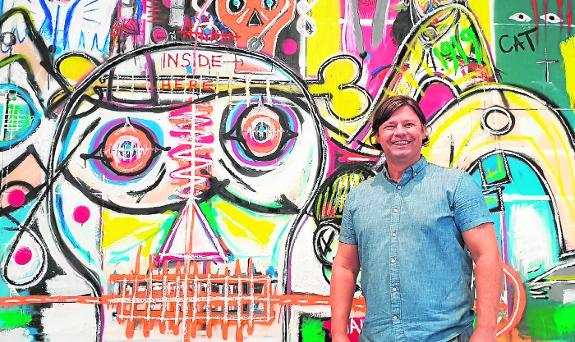Portrait of an artist with dyslexia
Dubliner Pigsy, 48, has struggled with dyslexia all his life and he explains to SUR in English how he used his disorder to influence his art
Tony Bryant
Miércoles, 9 de septiembre 2020, 13:10
Dyslexia is a reading disorder that changes the way millions of people read and process information, but not many people understand how it shapes the confidence of people who have it, especially those with artistic tendencies.
Born in Dublin in 1972, established architect and artist Ciaran McCoy has struggled with dyslexia all of his life. Because he was born on Dublin's Northside, he was at first embarrassed to show people his art for fear they would think he was an "eejit", but he eventually overcame his inhibitions and today he has received much recognition for his work, which he describes as the "no phony approach".
His father worked as a tiler who specialised in mosaic designs and he has also nurtured a lifelong passion for painting, so it was only natural that Ciaran would develop a passion for art.
After enjoying multiple successful solo exhibitions in Dublin, Ciaran, who paints under the alter-ego Pigsy, has now moved to Malaga to take a break from architecture and focus on his painting and drawing.
Prior to arriving in Spain, Ciaran was featured in a short film that was selected for the Irish Film Festival in London. The eight-minute film - which at first he was not keen to make - tells the story of an artist who struggled with severe dyslexia. It focuses on his school days, when being dyslexic brought him feelings of shame and inferiority.
"At first, Mum just said I was slow. My dad didn't want me to be labelled, so dyslexia was never really discussed. I was enrolled in additional classes to learn how to deal with the disorder for the majority of my academic life. It was initially a lot of frustration, but this eventually turned into negative energy," the 48-year-old Dubliner explained to SUR in English.
Ciaran began venting his frustration by drawing with chalk, which he would steal from school: today, depending on what feels right at the time of painting, he uses a mixture of chalk, charcoal, acrylics and spray paint.
Semi-biographical
Many of his paintings are self-portraits, or semi-biographical. His work has been described as 'angry' and 'aggressive', but the artist disagrees, claiming he is simply expressing "the frustrations of someone who lives with dyslexia".
"I like to draw quick and loose. I think if you're drawing fast there's an honesty to it because there is no manipulation and over thinking, it's just straight from your head onto the canvas. Sometimes a word comes into my mind and I need to get it out because its wrecking my head. This leads me down a rabbit hole of emotions and thoughts. I like to see where this leads me, because it's what is going on in my head at the time," Ciaran said.
Spontaneity and frustration
The canvas becomes his "battleground" and the media he uses are the "tools of resolution and understanding". His paintings have added text and they are unique in that they have no boundaries: they portray spontaneity, frustration, simplicity and emotion.
The artist does not correct misspelt words, and, unlike before - when he tried not to reveal too much of his disorder to the outside world - he does not try to conceal them with splashes or spills of paint.
"Words frustrate me and fascinate me at the same time. I sometimes don't understand the sounds of the letters, what they mean and why they don't do what they are supposed to do, but I never correct them," he explains.
One of the first paintings he has produced since arriving in Malaga is called Seven Spanish Angels, a huge canvas that is dedicated to seven revered Spanish artists, which includes Picasso, who Ciaran refers to as the "godfather of art".
"When I arrived in Malaga I thought, OK, I'm in Picasso territory now.
"Seven Spanish Angels is a nod towards the Spanish masters. Basically, I'm saying, 'I've arrived here on your turf and I am going to create lots of great things here'," the artist concludes.
